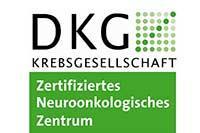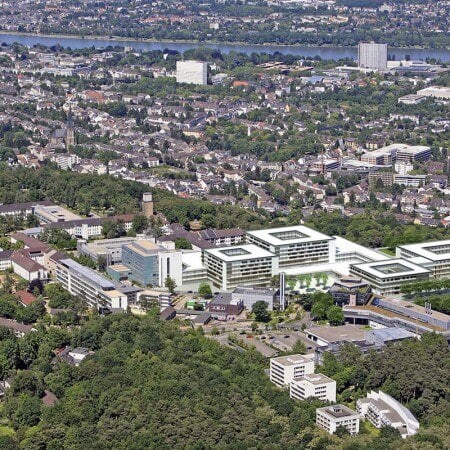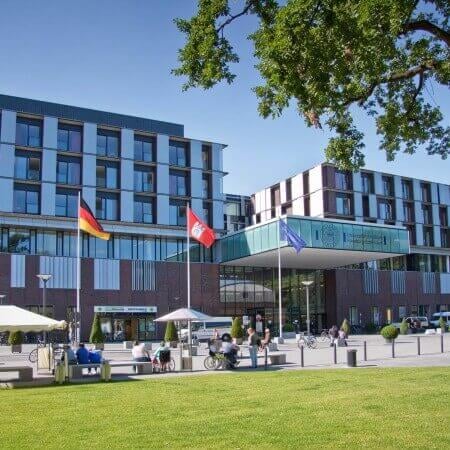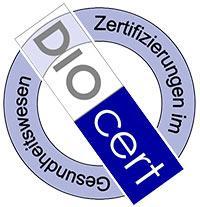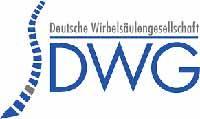Brain aneurysms are abnormal bulges in the blood vessel wall. They only cause symptoms when they reach a gigantic size, which is rare. But even asymptomatic aneurysms pose a threat to health and life since in the event of a rupture they cause a subarachnoid hemorrhage. The larger the aneurysm, the higher the risk of bleeding. You can undergo treatment for this disease in Germany. Doctors in this country use neurosurgical interventions and minimally invasive endovascular procedures to remove aneurysms from the bloodstream. For complex or multiple aneurysms, both approaches can be used simultaneously.
Content
- What are brain aneurysms and why do they develop?
- Diagnostics
- Surgical treatment
- Endovascular treatment
- Which treatment is better: open surgery or endovascular procedures?
- How to undergo brain aneurysm treatment in Germany?
What are brain aneurysms and why do they develop?
Aneurysms develop at sites where the blood vessel wall is weakened. The blood flow gradually protrudes from it, thereby creating a sac. Over time, the aneurysm extends as the blood vessel wall continues to stretch, and at some point, it may rupture.
Aneurysms are classified into several categories by their size. Large aneurysms ranging from 6 to 25mm and giant aneurysms more than 25mm are considered dangerous. Most of these formations are sac-shaped. 85% of aneurysms are located at the junction or bifurcation of the blood vessels of the circle of Willis.
Most aneurysms are acquired diseases. They may develop due to the following risk factors:
- elderly age;
- smoking;
- arterial hypertension;
- atherosclerosis;
- alcohol abuse.
Less common causes are cocaine addiction, tumors, injuries, and infective endocarditis.
Large and multiple aneurysms are usually more common in patients with genetic disorders, such as autosomal dominant polycystic kidney disease, Ehlers-Danlos syndrome, fibromuscular dysplasia, tuberous sclerosis, arteriovenous malformations, and coarctation of the aorta.
Brain aneurysms are common: 3% of the world's population has them, but mostly they are small and do not threaten health. The ratio of men and women affected with this disease up to 50 years old is the same. After the age of 50, the risk in women is twice as high, which is associated with lower estrogen levels. Approximately 0.5% of people in the world die because of a subarachnoid hemorrhage, which has developed as a result of a ruptured aneurysm.
Diagnostics
Most unruptured aneurysms do not cause any symptoms. They are detected during an MRI scan by chance when the patient is examined for other diseases.
With the already developed hemorrhage caused by the aneurysm as a result of its rupture, neurological symptoms manifest themselves. These patients usually undergo a CT scan immediately. It has a sensitivity of 100% if carried out in the first 6 hours after the hemorrhage, and 92% when carried out during the very first day. If more time has passed, the MRI scan becomes a more informative diagnostic method.
A lumbar puncture is performed for patients who have already suffered a hemorrhage. The doctor inserts a needle into the lower back to obtain a sample of cerebrospinal fluid. If there is blood in it, it confirms the hemorrhage.
In patients with ruptured aneurysms, it is important to identify the source of the hemorrhage to treat it later. Angiography is considered the "gold standard" for diagnostics. Doctors insert a catheter into the arterial bed, use contrast enhancement for the blood vessels, and make X-ray scans. Doctors in Germany also use non-invasive diagnostic methods: CT angiography and MR angiography. When performing these diagnostic tests, physicians make an intravenous contrast agent injection.
Surgical treatment
Surgical interventions for brain aneurysms have been performed since 1885 when the aneurysm wall was wrapped in a muscle to strengthen it. Today, however, this approach is not being used. Already in 1937, doctors put a clip on the aneurysm for the first time. This exclusion method of pathological vascular formation from the bloodstream remains relevant, but only clips and surgical techniques are modified.
Aneurysm clipping is the imposition of a clip on the neck of the aneurysm. For this purpose, a standard neurosurgical approach is formed, with craniotomy. The operation is performed under general anesthesia. The doctor temporarily removes a small section of the skull, opens the dura mater, and separates it from the blood vessels under the control of an operating microscope. Then, the aneurysm is removed from the bloodstream with a clip. The skull defect is closed with a plate. The plate is fixed with screws, after which the doctor sutures the soft tissues.
Over time, the aneurysm decreases and then turns into a scar. The clip remains inside the head all life, but it has a minimal size, so the patient does not feel it. It also does not cause any complications.
In the aneurysms treatment of typical localization, the efficiency of the surgical intervention exceeds 90%, and in the best German hospitals, it reaches 96%.
Doctors in Germany perform surgery using modern neuronavigation systems and powerful surgical microscopes. They allow performing safe surgery with a low risk of damage to the functionally important regions of the brain. Accordingly, the risk of developing neurological complications is reduced. Modern microsurgical techniques ensure the preservation of a good blood supply to the brain.
In about two out of three cases, surgery is performed on patients who have already suffered a subarachnoid hemorrhage. Even in such difficult situations, German neurosurgeons successfully deal with aneurysm treatment and eliminate the consequences of the hemorrhage. The surgical intervention is followed by rehabilitation, which helps to restore the impaired functions of the central nervous system.
Endovascular treatment
Surgeons in Germany are increasingly using the endovascular technique instead of open surgical treatment. Doctors carry out the necessary manipulations through the blood vessels. The intervention purpose is to remove the brain aneurysm from the bloodstream and thereby prevent brain hemorrhage.
Advantages
The endovascular treatment of aneurysms is less traumatic. Physicians do not need to make holes in the skull to access the vascular mass. They insert instruments through the blood vessels. Micro coils are delivered to the aneurysm site, which stimulates the aneurysmal sac thrombosis and removes the aneurysm from the bloodstream.
With endovascular procedures, German hospitals successfully treat even patients with complex aneurysmal sac configurations, eliminate multi-chamber aneurysms, multiple aneurysms, fusiform aneurysms, giant aneurysms, aneurysms accompanied by atherosclerotic changes, and wide-necked aneurysms. The procedure allows healthcare professionals to remove the aneurysm from the bloodstream in 80% of cases, and in the remaining 20% of cases, blood flow is significantly reduced, which minimizes the risk of the aneurysm rupture.
New endovascular treatment techniques
The endovascular technique for brain aneurysms treatment has been used relatively recently. The first embolization with a platinum micro coil was carried out in 1991 in Italy. The procedure was approved by the FDA in 1995 and began to be used in the United States.
As of today, endovascular treatment techniques are constantly being improved. There are now such intra-arterial procedures available:
- balloon-assisted and stent-assisted endovascular treatment with micro coils;
- implantation of flow-diverting stents that remodel the blood flow in the aneurysm.
The introduction of these techniques has significantly expanded the indications for endovascular treatment. Along with surgical interventions, minimally invasive manipulations are now considered one of the possible first-line treatment options for patients with aneurysms. Endovascular treatment is easier to tolerate, less likely to lead to complications, and has much lower mortality and minimal risk of disability.
In the case of the wide-necked aneurysm, doctors use a balloon. It is inflated in front of the neck at the moment of placement of the micro coil, thereby increasing the packing density of the micro coil and preventing its loss. Modern endovascular neurosurgeons have in their arsenal balloons with different patency and the ability to change shape. There are round balloons, oblong balloons, and also transformer balloons. Many techniques have been developed to close any aneurysm: double remodeling technique, retrograde occlusion, the use of several micro coils simultaneously, etc.
Another achievement of endovascular surgery is the stent-assisted hemodynamic remodeling technique. It reduces the risk of recanalization, which is the blood flow restoration in the closed aneurysm. Several stents have been developed, which are divided into open-cell and closed-cell ones. Each type has advantages and disadvantages, so doctors use different options depending on the clinical situation. Surgeons use various techniques to remove the aneurysm from the bloodstream using stents: the "jailed-catheter technique" and the "trans-cell technique" for arterial wall reconstruction, the "Y stent-assisted coiling&waffle-cone technique" and the "X-stent technique" for the stenting of aneurysm bifurcations.
Complications
Endovascular treatment is safer than open surgery, but still sometimes causes complications. Their frequency is not the same in different hospitals. In some hospitals, up to 25% of patients suffer from complications. In specialized German centers, the incidence of complications is about 5%. The main ones are as follows:
- intraoperative angiospasm (vasoconstriction);
- intraoperative aneurysm rupture;
- coil turn migration;
- recanalization (restoration of patency) of the embolized aneurysms.
Which treatment is better: open surgery or endovascular procedures?
Each approach has its advantages and disadvantages. Whenever possible, doctors in developed countries prefer endovascular treatment, as it is less traumatic. Endovascular procedures are considered a first-line treatment option in patients with the aneurysm localization in the vertebrobasilar system (except for of the aneurysms of the posterior inferior cerebellar artery) and the paraclinoid localization.
And yet, in some situations, it is impossible to cope with an aneurysm without a neurosurgical operation. The microsurgical method of the aneurysm elimination is more reliable when using it; the frequency of complete exclusion of the aneurysm from the bloodstream is higher, and the percentage of the aneurysm recanalization is lower. In addition, surgery is preferable in symptomatic patients, as it allows doctors to quickly eliminate the clinical manifestations of the disease by reducing the volume of vascular mass.
When deciding on a treatment option, neurosurgeons consider the following:
- the size of the brain aneurysm;
- its localization, which determines the success of an open surgical or endovascular approach;
- the number of aneurysms;
- structural features;
- the presence of hemorrhage due to the aneurysm in the patient's medical history;
- the severity of the patient's condition and his age.
The specialized German centers perform hybrid operations that combine neurosurgical interventions with endovascular procedures. They are used for complex and multiple aneurysms and can significantly reduce the trauma rate of treatment without compromising the clinical outcome.
How to undergo brain aneurysm treatment in Germany?
If you are going to have treatment for a brain aneurysm in one of the German hospitals, the Booking Health service will be helpful. Our website allows you to get up-to-date and accurate information about the cost of treatment in Germany, compare prices in different German hospitals, and make an appointment for treatment. The treatment in Germany will be easier and faster for you, and the cost of treatment in Germany will be lower.
Please leave your request on the website of the international medical tourism agency Booking Health. Our employees will contact you, provide advice, and answer your questions. We will take care of the arrangements for your trip. We will provide the following benefits to you:
- We will select a German hospital whose doctors specialize in the treatment of cerebrovascular diseases and achieve the best results.
- We will help you overcome the language barrier and communicate freely with a doctor at the German hospital.
- The waiting period for the treatment in Germany will be reduced for you, and you will receive medical care on the most suitable dates.
- We will reduce the price. The cost of treatment in Germany will be lower than usual. It will be reduced due to the elimination of overpricing and additional coefficients for foreign patients.
- Our specialists will solve any organizational issues: paperwork, transfer from the airport to the German hospital, and back, hotel booking, and interpreting services.
- We will prepare your documents and translate them into English or German. You do not have to repeat the previously performed diagnostic procedures.
- We will keep in touch with the German hospital after the completion of your treatment in Germany.
- We will arrange additional treatment in Germany, diagnostics, or rehabilitation if required.
- We will buy medicines in Germany and forward them to your native country.
While the best specialists in the world are taking care of your health, the Booking Health staff will help reduce the cost of treatment in Germany and take care of all the travel arrangements.
Authors:
The article was edited by medical experts, board certified doctors Dr. Nadezhda Ivanisova and Dr. Sergey Pashchenko. For the treatment of the conditions referred to in the article, you must consult a doctor; the information in the article is not intended for self-medication!
Sources:
MedicineNet
Sience Direct
Verywell Health



